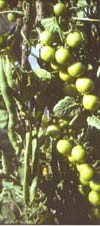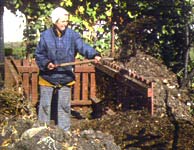|
Biogardener Homepage with links to my other websites
Getting Started Organically
Biogardener Tips
Edible Gardening
Trees & Shrubs
Environmental Issues
Meet Traute Klein
 . . 
Related Articles
Why Environmental Gardening?
Companion Planting
Leaves of Gold


Amazon BooksRodale's All-New Encyclopedia of Organic Gardening
Organic Gardening for the 21st Century A Complete Guide to Growing Vegetables, Fruits, Herbs and Flowers
| Start an Organic Garden the Easy Wayby Traute Klein, biogardener
My Dream
Let me share with you some tips on getting started, tips which I learned by experimenting. The photos were taken during the early days of this creation process.
The Setting
What an opportunity! I was free to do as I pleased, as I had always dreamed.
Getting Started
The No-Dig Method Digging up trees, weeds, and lawn was impossible. I therefore decided to choke them to death. Any vegetation will die within a year if kept from breathing. A plastic cover does the trick, but has to be removed before the area can be cultivated. Leaving the plastic in place promotes fungus diseases. A heavy layer of newspaper works without the need for later removal. I held the newspapers down with compostable material as well as mulch and soil. I covered a comfortably sized area at a time and piled the newspapers and the compostable material on it. I then found some soil which I used to cover the compost. When that cover was at least 10" high, seed could be sown into it or seedlings set. Only above-ground produce was adaptable to this method. No carrots or potatoes. I found that out the hard way. During the first year, I had great potato plants without much underground activity. No matter. I learned from the experience. I remembered from my childhood on Germany that cucurbits, like pumpkin, cucumber, and squash, can be seeded right into a compost pile. They love the moisture and the decomposition heat. I grew a lot of cucurbits the first few years. Digging or tilling the soil first is counterproductive, because it brings more weed seeds to the surface. The Dig Method As the lawn disappeared and I started to work my way through the garden the second time, I was able to do some digging using a long-handled shovel, which gave me lots of leverage. A 4’ square spot was a comfortable area to work on at one time. I would start with a hole of any depth, depending on the amount of pain I was suffering that week. In that hole, I would throw all compostable material, starting with the coarsest, like tree branches. I paid no attention to the order in which I deposited the material, as long as I had about equal parts of brown, carbon-rich material compared to green, nitrogen-rich material. When I had a good pile on that hole, I would start digging another hole and use the soil from the second hole to cover the pile in the first. As soon as the soil cover was applied, I would again sow some seeds. The Raised Bed Method When I had building material for raised beds, I would place them where they would remain and fill them like a compost bin. They, too, got piled high and were then covered with soil. This turned out to be my favorite method, because it allowed me to garden without bending down. The Result

|
The material on this site may be reproduced or republished only by special arrangement with the webmaster.
You are, however, welcome to pass on or link the URL.